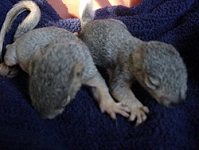|
|
All tree squirrels are diurnal and arboreal, but the range of vertical activity in species differs widely, especially among those living in tropical rainforests. Some, such as the Oriental giant squirrels (genus Ratufa) and the African giant squirrels (genus Protoxerus), rarely descend from the high canopy.
Others, like the pygmy squirrel of Sulawesi (Prosciurillus murinus), travel and forage at intermediate levels between ground and canopy.
|
Some large tropical squirrels, such as the Sulawesi giant squirrel (Rubrisciurus rubriventer) and the northern Amazon red squirrel (Sciurus igniventris), nest at middle levels but travel and forage low in the understory or on the ground.
The African palm squirrels (genus Epixerus) are long-legged runners that forage only on the ground. Certain species, such as the red-tailed squirrel (S. granatensis) of the American tropics and the African pygmy squirrel, are active from ground to canopy.
In the United States, the Eastern fox squirrel (S. niger) runs along the ground from tree to tree, but others, including the Eastern gray squirrel (S. carolinensis), prefer to travel through the treetops and regularly cross rivers by swimming with the head up and tail flat on the water's surface. Thomas's rope squirrel (Funisciurus anerythrus) of Africa even submerges itself and swims underwater.
Most tree squirrels have strong chisel-like incisors and powerful jaws, which are required for gnawing open the hard nuts that, along with fruits, are a primary component of their diet. They also eat seeds, fungi, insects and other arthropods, the cambium layer of tree bark, nectar, leaves, buds, flowers, and sometimes bird eggs, nestlings, and carrion. Some red squirrels (genus Tamiasciurus) and Sciurus species of temperate climates will stalk, kill, and eat other squirrels, mice, and adult birds and rabbits for food, but such predation in tropical tree squirrels seems rare. |

|
Nests are constructed among branches in the forest canopy or at lower levels in tree crowns, vine tangles, tree hollows, or undergrowth near the ground. Some species of tropical tree squirrels produce several litters per year; breeding season in the Northern Hemisphere may extend from December to September and may result in one or two litters that average three to seven young, depending upon the species.
In the New World, tree squirrels range from the boreal forests of Canada and Alaska southward through coniferous and deciduous woodlands in the United States to the tropical rainforests of South America. In Africa, tree squirrels are native to rainforests and some woodland savannas.
Their distribution in the remainder of the Old World extends from the northern boreal forests of Europe and Asia to the Indonesian tropical rainforests. East of the Asian continental margin, tree squirrels inhabit the forests of Taiwan, some islands in the Philippines, and Sulawesi, but they do not occur naturally anywhere east of those islands. Most of the species in 20 of the 22 genera are found in tropical rainforests.
|



